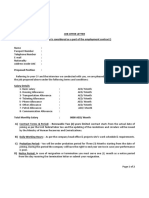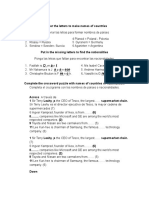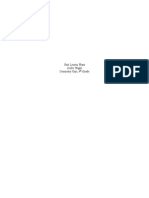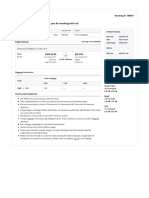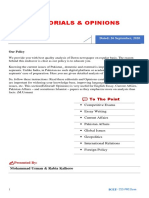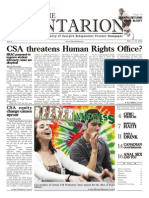Lesson 1 Unit Plan
Lesson 1 Unit Plan
Uploaded by
api-300384449Copyright:
Available Formats
Lesson 1 Unit Plan
Lesson 1 Unit Plan
Uploaded by
api-300384449Original Title
Copyright
Available Formats
Share this document
Did you find this document useful?
Is this content inappropriate?
Copyright:
Available Formats
Lesson 1 Unit Plan
Lesson 1 Unit Plan
Uploaded by
api-300384449Copyright:
Available Formats
Lesson Planning Form for Accessible Instruction Calvin College Education Program
Teacher
Mrs. Albaitis, Jake Horstman
Date
Oct. 27
___3rd_________
Subject/ Topic/ Theme
Measurement, Measuring
Grade
I. Objectives
How does this lesson connect to the unit plan?
Students will learn how to measure line segments to the nearest inch, half, and quarter inch. Students will review what measuring is and learn how to measure objects.
Unit is about measuring.
cognitiveR U Ap An E C*
Learners will be able to:
Measure line segments to the nearest full inch, half, and quarter inch with rulers.
Recognize tick marks on a ruler and what the ticks represent
Relate fractions to measuring with rulers
Create a specified length line segment
Estimate lengths of line segments
physical
development
U
U
Ap
Ap
socioemotional
X
X
Common Core standards (or GLCEs if not available in Common Core) addressed:
Use appropriate tools strategically. CC.3.MP.5]
Attend to precision. [CC.3.MP.6].
Represent and interpret data. [CC.3.MD.3]
(Note: Write as many as needed. Indicate taxonomy levels and connections to applicable national or state standards. If an objective applies to particular learners
write the name(s) of the learner(s) to whom it applies.)
*remember, understand, apply, analyze, evaluate, create
II. Before you start
Identify prerequisite
knowledge and skills.
Knowledge of Fractions, possibly know what measuring is? How they have seen it used before?
Pre-assessment (for learning):
The unit pre-assessment will be given before this lesson so that I know what students know or do not
know as I develop future lesson plans.
Outline assessment
activities
(applicable to this lesson)
Formative (for learning):
No quiz given before this lesson
Formative (as learning):
Summative (of learning):
What barriers might this
lesson present?
What will it take
neurodevelopmentally,
experientially,
emotionally, etc., for your
students to do this lesson?
1-19-13
Provide Multiple Means of
Representation
Provide options for perceptionmaking information perceptible
Projector in front of class to make
pages visible and students can
follow along. Also their workbooks.
Provide Multiple Means of Action
and Expression
Provide options for physical actionincrease options for interaction
All students will be given
whiteboards. If students cannot
raise boards to show answers they
can get help from an elbow partner.
Desks will be set up for all students
to easily navigate the classroom.
Provide Multiple Means of
Engagement
Provide options for recruiting
interest- choice, relevance, value,
authenticity, minimize threats
All students will participate on the
same worksheets. All of them can
help each other and they all will be
on the same questions. Few
problems will be done on the board
and selected students can complete
this with the class
Provide options for language,
mathematical expressions, and
symbols- clarify & connect
language
Tick marks on rulers mean
different things. Will have
labels on ticks so students know
what each one means
Provide options for comprehensionactivate, apply & highlight
Workbooks and sheets to
practice and hands on examples
to apply the concepts taught in
class.
Materials-what materials
(books, handouts, etc) do
you need for this lesson
and are they ready to
use?
Provide options for expression and
communication- increase medium
of expression
Provide options for sustaining effort
and persistence- optimize
challenge, collaboration, masteryoriented feedback
Students have whiteboards and
can display answers and
thoughts on board for teacher to
see. When they are in front of
class they can use a microphone
for all students to hear.
Students can agree or disagree
with other students with
problems on board or elbow
Partners to solve different
problems in workbook.
Provide options for executive
functions- coordinate short & long
term goals, monitor progress, and
modify strategies
Provide options for self-regulationexpectations, personal skills and
strategies, self-assessment &
reflection
This lesson will be tested at
Students can monitor their own
the next lesson. No little quiz
progress through homework and
will be given so students will
completing worksheet problems
not be able to monitor progress
at the end of the lesson.
until the next day.
At the end of the day a
homework sheet will be taken
home to be completed for the
next day.
Math Expressions workbook, ruler, pencil, paper, eraser, whiteboard and dry-erase markers, desk,
chair.
Students will be at their own individual desk. Teacher will be at the front of classroom at kidney table.
Desks can be in rows or columns, depending on students needs and behavior
How will your classroom
be set up for this lesson?
III. The Plan
Time
Components
Motivation
(opening/
introduction/
engagement)
Development
(the largest
component or
main body of
the lesson)
1-19-13
Describe teacher activities
AND
student activities
for each component of the lesson. Include important higher order thinking questions and/or
prompts.
Teacher asks: what jobs do you know where people Students give responses to questions
use measurement? Have you ever used
measurement? (could continue a small conversation
off of what a student says if it relates to
measurement or if teacher can connect
measurement further to what students says)
Provide a history of measurement, how people way
back in the day measured things.
In the 1600s they didnt have standard units of
measure so they used body parts.
Body part that ended up be universal was the
Kings hand or foot.
Measure a desk with hands (relates to opening
motivation comment about history).
Different responses will happen. Then you can say
you are the king and you will just use your hand or
foot to measure. But, eventually you will leave so
there will be a new measurement. This is very
inefficient. So Standard units were implemented.
Record methods of measurement on board for
students to see
Students can measure desk with their own hands
and then can discus the different results. (why is
this so?)
Discus different methods of measurement (units
and tools).
Relate measurement to previous units (so they
already learned about area and perimeter. That is
measurement and we can also talk about width,
length and height)
Synonyms of measurement: size, amount, volume,
area, and weight. To further understanding of what
measurement is.
Turn to page 159 in their books and follow along or
complete problems.
Get ruler, pencil and paper to create line segments.
Have students turn to page in their workbooks
Discus how a ruler works and how to measure
using a ruler. Work through three examples in
book. (pg. 159)
Draw Line segments with rulers. First walk
students through one or two examples of line
segments at a specified length. Them let them try
them on their own.
Turn to page 160 and complete page.
Define estimation: syn. Approximation, guessing,
guess.
Student workbook page 160
Complete number 7. Students try number 8
Closure
(conclusion,
culmination,
wrap-up)
Students can complete page 160 then clean up their
supplies so that they can be dismissed for lunch
Clean up their desk and supplies so they can start
next subject or lunch
End of the day homework will be passed out. It
will be the 3-1 remember and homework sheet to
be completed for the next class session
Students take home 3-1 worksheet to be completed
for the next day.
Your reflection about the lesson, including evidence(s) of student learning and engagement, as well as ideas for improvement
for next time. (Write this after teaching the lesson, if you had a chance to teach it. If you did not teach this lesson, focus on the
process of preparing the lesson.)
This lesson went all right, personally speaking. This was the first lesson of the unit for I also had to introduce the unit along
with the lesson. I started by asking the students to measure their desk with their hand span. All of the students participated
measuring and about 8 of the students immediately raised their hands when I asked for an answer. All of the students were in
agreement that a more universal method should be recognized for measuring because each of the students hands are
different sizes. When I asked for tools or units of teaching the students came up with: tape measure, ruler, meter stick, inches,
feet, meters, centimeters, and yards. It was not difficult to get answers from students; it was harder, however, to get chatting
and conversations to stop after I asked suggestions from the class. Today many of the students were distracted. Before this
lesson I led a small group and they had a harder time focusing on the reading than they have in the past days. 5 times
throughout this lesson I had to pause and ask the students to quiet down because I could not hear one of the students
responses to a question I had asked. When I introduced a ruler and taught how to read it, I saw many students had a puzzled
look on their face. I think it may have been due to all of the marks on the ruler, they were overwhelming the students. I tried
my best to break down the ruler into fourths, which was a curriculum standard they needed to know, and clearly distinguish
the fourths and half tic-mark. I saw that most of the students understood how to use a ruler by the end of the lesson because I
assigned them a few problems which involved drawing a line segment to the nearest inch, half-inch, and quarter-inch.
Looking back I think I would have slowed down my instruction when teaching about the ruler. I think I also would have told
the students how to write fractions when measuring, I saw on their worksheets that about 10 of them wrote the length wrong
but when I asked they knew exactly how long it was. I think also I need to think out a good conclusion to somewhat wrap up
the lesson. What I did was have the students complete a page in their workbook and then summarize what they did in the
book and what we covered in class. I think if I did it again I would have a better transition into the next topic, and a better
closure of this lesson. I would quiz the students on what they were just taught to see if they could put it into words.
1-19-13
1-19-13
You might also like
- Job Offer DraftDocument2 pagesJob Offer DraftWael Ahmed100% (1)
- Udl Lesson Plan - Ed 4702Document6 pagesUdl Lesson Plan - Ed 4702api-242345831No ratings yet
- g4 Area and Perimeter UnitDocument20 pagesg4 Area and Perimeter Unitapi-249159678No ratings yet
- Reorder The Letter To Make Names of CountriesDocument11 pagesReorder The Letter To Make Names of CountriesHeidy De Alejandra67% (3)
- Fourth Grade Math Area and Perimeter Lesson PlanDocument6 pagesFourth Grade Math Area and Perimeter Lesson Planapi-273149494100% (6)
- Lesson 5-Using Similar TrianglesDocument4 pagesLesson 5-Using Similar Trianglesapi-269787508No ratings yet
- CHESSDocument3 pagesCHESSJoseph R. Galleno100% (2)
- Solids Flow Meter, Type DLM Solids Flow Feeder, Type DLD: Operating ManualDocument20 pagesSolids Flow Meter, Type DLM Solids Flow Feeder, Type DLD: Operating ManualArturMirandaNo ratings yet
- Service Manual 00891036.f06 enDocument792 pagesService Manual 00891036.f06 enWilson Rsm100% (2)
- Lesson 2 Unit PlanDocument5 pagesLesson 2 Unit Planapi-300384449No ratings yet
- Winning EstimateDocument9 pagesWinning Estimateapi-242926820No ratings yet
- Day 3 of UnitDocument3 pagesDay 3 of Unitapi-270334633100% (1)
- Reflective Lesson Plan-MathDocument13 pagesReflective Lesson Plan-Mathapi-217594944No ratings yet
- Curriculum Outcomes: Lesson # 1 Teach Er Date Time Unit/Stra ND GradeDocument4 pagesCurriculum Outcomes: Lesson # 1 Teach Er Date Time Unit/Stra ND Gradeapi-242345831No ratings yet
- West Virginia State University Lesson PlanDocument10 pagesWest Virginia State University Lesson Planapi-283691486No ratings yet
- Stoffer Early Childhood Plans For Learning SegmentDocument7 pagesStoffer Early Childhood Plans For Learning Segmentapi-253427643No ratings yet
- Formal Lesson Plan 4Document5 pagesFormal Lesson Plan 4api-383424069No ratings yet
- Grade Level Being Taught: 3rd Subject/Content: Math Group Size: Whole and Small Date of Lesson: 1/27/15Document9 pagesGrade Level Being Taught: 3rd Subject/Content: Math Group Size: Whole and Small Date of Lesson: 1/27/15api-247251809No ratings yet
- Math Lesson Plan 2nd GradeDocument5 pagesMath Lesson Plan 2nd Gradeapi-317499591No ratings yet
- Lesson 2 Perimeter and Area in The Coordinate PlaneDocument3 pagesLesson 2 Perimeter and Area in The Coordinate Planeapi-283338157No ratings yet
- Lesson Plan ClocksDocument3 pagesLesson Plan Clocksapi-300472292100% (2)
- MathunitDocument27 pagesMathunitapi-349893685No ratings yet
- Measurement Lesson Length1Document4 pagesMeasurement Lesson Length1api-242505437No ratings yet
- LessonstudylessonplanDocument3 pagesLessonstudylessonplanapi-250964578No ratings yet
- Lesson 1 of Unit Plan 302Document3 pagesLesson 1 of Unit Plan 302api-300681621No ratings yet
- Pre-Student Teaching Lesson PlanDocument15 pagesPre-Student Teaching Lesson Planapi-346855151No ratings yet
- Lesson Plan: Step 1: Curriculum ConnectionsDocument5 pagesLesson Plan: Step 1: Curriculum Connectionsapi-390378000No ratings yet
- Hearing Impaired Lesson PlanDocument6 pagesHearing Impaired Lesson Planapi-316000846No ratings yet
- Lesson 2 For PortfolioDocument9 pagesLesson 2 For Portfolioapi-283691486No ratings yet
- Edfd Assignment 1 - Lesson PlanningDocument8 pagesEdfd Assignment 1 - Lesson Planningapi-294620957No ratings yet
- Lesson Plan Title: Comparing Lengths in Centimeters Subject/Grade: Mathematics/2 1 Learning Outcomes/ObjectivesDocument2 pagesLesson Plan Title: Comparing Lengths in Centimeters Subject/Grade: Mathematics/2 1 Learning Outcomes/Objectivesapi-312576877No ratings yet
- Science Unit Lesson 4Document3 pagesScience Unit Lesson 4api-252387195No ratings yet
- Dakota State University College of Education Lesson Plan FormatDocument5 pagesDakota State University College of Education Lesson Plan Formatapi-347721109No ratings yet
- Math Field LessonsDocument11 pagesMath Field Lessonsapi-337179959No ratings yet
- Lesson Plan 1Document3 pagesLesson Plan 1api-334861434No ratings yet
- Unit 6Document4 pagesUnit 6api-245823147No ratings yet
- (If Applicable, If Not Explain Why) : (Demonstration of Learning)Document3 pages(If Applicable, If Not Explain Why) : (Demonstration of Learning)api-282904450No ratings yet
- Lesson Planning Form For Accessible Instruction - Calvin College Education ProgramDocument5 pagesLesson Planning Form For Accessible Instruction - Calvin College Education Programapi-336528722No ratings yet
- 6th Grade Math ProportionsDocument2 pages6th Grade Math Proportionsapi-236052859No ratings yet
- Example Lesson PlansDocument15 pagesExample Lesson Plansapi-289863780No ratings yet
- Millicent Atkins School of Education: Common Lesson Plan TemplateDocument37 pagesMillicent Atkins School of Education: Common Lesson Plan Templateapi-444858079100% (1)
- Lesson 3 Unit PlanDocument3 pagesLesson 3 Unit Planapi-300384449No ratings yet
- Ubd Planning Template With QuestionsDocument3 pagesUbd Planning Template With Questionsapi-217297849No ratings yet
- Lesson 1 Plan FormDocument6 pagesLesson 1 Plan Formapi-336528722No ratings yet
- Lesson Plan Educ 230Document3 pagesLesson Plan Educ 230api-212848090No ratings yet
- Trillet - Discussion 4Document10 pagesTrillet - Discussion 4api-311952511No ratings yet
- Math Lesson PerimiterDocument6 pagesMath Lesson Perimiterapi-340404014No ratings yet
- Pacheco Signatureassignment Ble407Document24 pagesPacheco Signatureassignment Ble407api-293667101No ratings yet
- Lesson Plan 3Document3 pagesLesson Plan 3api-338888247No ratings yet
- 3 Timeline Lesson ModifiedDocument4 pages3 Timeline Lesson Modifiedapi-337281159No ratings yet
- 1-Scoe Lesson Planning Template Fa23 2 1Document5 pages1-Scoe Lesson Planning Template Fa23 2 1api-583052012No ratings yet
- Lesson Plan - MathsDocument4 pagesLesson Plan - Mathsapi-250080978No ratings yet
- Inch by Inch Lesson PlanDocument3 pagesInch by Inch Lesson PlanYashmeeta SharmaNo ratings yet
- Taylor Scottunit Lesson 3Document3 pagesTaylor Scottunit Lesson 3api-235236994No ratings yet
- Ed 302 Unit Plan Lesson 4 PDFDocument4 pagesEd 302 Unit Plan Lesson 4 PDFapi-300683985No ratings yet
- Geralynn Otero Final Lesson PlanDocument5 pagesGeralynn Otero Final Lesson Planapi-644888167No ratings yet
- 2014-2015 ObservationDocument5 pages2014-2015 Observationapi-288051646No ratings yet
- Lesson Plan - Repeated AdditionDocument3 pagesLesson Plan - Repeated Additionapi-302003110100% (1)
- Lesson 4 Volume of Prisms and CylindersDocument4 pagesLesson 4 Volume of Prisms and Cylindersapi-283338157No ratings yet
- Day 2 UnitDocument3 pagesDay 2 Unitapi-270334633No ratings yet
- Math Lesson PlanDocument3 pagesMath Lesson Planapi-283529633No ratings yet
- Assignment 3Document7 pagesAssignment 3api-316106947No ratings yet
- Unit Lesson Plans Joelle Wight Geometry Unit, 4 GradeDocument32 pagesUnit Lesson Plans Joelle Wight Geometry Unit, 4 Gradeapi-281994074No ratings yet
- MPDFDocument4 pagesMPDFChene BolongonNo ratings yet
- Informational Text Toolkit: Research-based Strategies for the Common Core StandardsFrom EverandInformational Text Toolkit: Research-based Strategies for the Common Core StandardsNo ratings yet
- Lesson 8 On PrayerDocument4 pagesLesson 8 On Prayerapi-300384449No ratings yet
- Prayer Pre-AssessmentDocument1 pagePrayer Pre-Assessmentapi-300384449No ratings yet
- Lesson 5 On PrayerDocument4 pagesLesson 5 On Prayerapi-300384449No ratings yet
- Lesson 3 For PrayerDocument3 pagesLesson 3 For Prayerapi-300384449No ratings yet
- Lesson 5 UnitplanDocument3 pagesLesson 5 Unitplanapi-300384449No ratings yet
- Lesson 1 On PrayerDocument4 pagesLesson 1 On Prayerapi-300384449No ratings yet
- Lesson 3 Unit PlanDocument3 pagesLesson 3 Unit Planapi-300384449No ratings yet
- Sr. No Name JOINING DATE (Dd/mm/yy)Document5 pagesSr. No Name JOINING DATE (Dd/mm/yy)Babar MairajNo ratings yet
- Chapter 5. Egypt and Sudan Mesolithic To Early Dynastic (World Archaeology at The Pitt Rivers Museum)Document30 pagesChapter 5. Egypt and Sudan Mesolithic To Early Dynastic (World Archaeology at The Pitt Rivers Museum)Dan HicksNo ratings yet
- Packing, Marking and Shipping Procedure: Karun Petrochemical Hyco PlantDocument2 pagesPacking, Marking and Shipping Procedure: Karun Petrochemical Hyco PlantMohammad SadatNo ratings yet
- Case Study On Errors and FraudsDocument9 pagesCase Study On Errors and FraudsHariharan ShettyNo ratings yet
- Proceedings of 1st ICBAS 2016 18112016Document788 pagesProceedings of 1st ICBAS 2016 18112016suryaning100% (1)
- "Financial Statement Analysis and Financial Forecasting AT Kec International LTD" NagpurDocument7 pages"Financial Statement Analysis and Financial Forecasting AT Kec International LTD" NagpurAnonymous g7uPednI100% (1)
- Lesson Plan Budgeting 2 2Document2 pagesLesson Plan Budgeting 2 2Alexander QuemadaNo ratings yet
- Production of Transgenic Goats Expressing Human Coagulation Factor IX in The Mammary Glands After Nuclear Transfer Using Transfected Fetal Fibroblast CellsDocument9 pagesProduction of Transgenic Goats Expressing Human Coagulation Factor IX in The Mammary Glands After Nuclear Transfer Using Transfected Fetal Fibroblast CellsMaira QuintanaNo ratings yet
- Stonproof CT5 Product Data - en - USDocument2 pagesStonproof CT5 Product Data - en - USVentas ExpertisNo ratings yet
- Comparing The Victimization Impact of Cybercrime and Traditional CrimeDocument23 pagesComparing The Victimization Impact of Cybercrime and Traditional CrimeZhafran AlaricNo ratings yet
- Dear Ahmad Sagheer, Ticket is Con韌�rmed. Thank you for booking with us!Document1 pageDear Ahmad Sagheer, Ticket is Con韌�rmed. Thank you for booking with us!Inam ZahoorNo ratings yet
- Introduction To Chemical Engineering Thermodynamics: Appendix F PowerpointDocument39 pagesIntroduction To Chemical Engineering Thermodynamics: Appendix F PowerpointAlessandra Maria RodriguesNo ratings yet
- ICEP CSS - PMS Dawn 26 September, 2020 by M.Usman and Rabia KDocument44 pagesICEP CSS - PMS Dawn 26 September, 2020 by M.Usman and Rabia KNisarvurdRehhman AkrumButtNo ratings yet
- Discipline Problems in SchoolDocument5 pagesDiscipline Problems in SchoolSusanMicky0% (1)
- The History of The Integrated CircuitDocument38 pagesThe History of The Integrated CircuitDwaipayan BhattacharyaNo ratings yet
- Competency Based InterviewsDocument14 pagesCompetency Based InterviewsVictor RodriguesNo ratings yet
- Lesson 22 Henle Second Year LatinDocument2 pagesLesson 22 Henle Second Year LatinJennifer Jones100% (1)
- 23 Office AccountsDocument9 pages23 Office AccountsNguyenNo ratings yet
- Northwestern Medicine Ileostomy Diet GuidelinesDocument7 pagesNorthwestern Medicine Ileostomy Diet GuidelinesDipa HandraNo ratings yet
- Photon BrochureDocument1 pagePhoton Brochureshwetha281889242No ratings yet
- Chapter - 5. Factorization of Algebraic ExpressionsDocument36 pagesChapter - 5. Factorization of Algebraic ExpressionsAnkit LadhaNo ratings yet
- The Ontarion - February 4 2010Document23 pagesThe Ontarion - February 4 2010The OntarionNo ratings yet
- 191-3. Letter From VirgilDocument3 pages191-3. Letter From VirgilEthan LouNo ratings yet
- Epic PoemDocument6 pagesEpic Poemapi-241206778No ratings yet
- A Study in Executive-Judicial Conflict - The Indian CaseDocument22 pagesA Study in Executive-Judicial Conflict - The Indian Casesanikasunil1552No ratings yet
